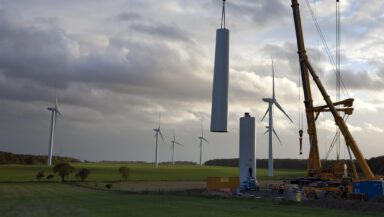On Friday, 8 Sept, the results of the government’s auction for renewable energy contracts will be announced. Through the Contract-for-Difference (CfD) auctions, the government awards 15-year contracts for low-carbon power generation projects such as solar and offshore wind farms. The scheme has been a key policy tool for delivering both cost reduction and certainty to developers to build more clean energy.
Offshore wind, onshore wind and solar have been the main beneficiaries – delivering nearly 29% of UK electricity generation last year. They are the fastest growing types of generation and will form the backbone of electricity decarbonisation, in the drive to deliver legally-binding carbon emissions reductions over the next decade.
Owing to rising cost pressures, but also inflexible government policy, it is now ‘highly likely’, according to Renewable UK, that there will be very few bids for offshore wind and onshore wind and solar could well be hard hit too.
This would result in this year’s auction being a complete flop, and represent the biggest failure for clean energy policy since 2015.
The failure arises from an effort to save consumers pennies that will actually cost them pounds. Wind and solar remain vastly cheaper than the alternatives for generating electricity (fossil gas) but are now unlikely to come forward for construction within this auction round.
This briefing seeks to explain why it is such a mistake for bill payers and the climate, and what it means for the government in meeting its own targets.
Why are contracts potentially not being awarded?
Contracts for fixed prices (called CfDs) are one of the most effective tools for keeping prices low, and attracting private investment into renewables. By having a fixed price, developers can go ahead with much lower risks (lower interest rates and supply chain confidence) whilst the government benefits by procuring renewable power for the UK at lower cost.
However, in order to bear down on the cost consumers pay, the government sets a ‘cap price’ for bids to get contracts. Companies know that bids at prices higher than the cap will not be awarded contracts, and if they can’t make the economics of the project go below that price, then they can’t be awarded a contract.
In the renewable energy supply chain, there has been serious supply chain inflation, which has been running higher than the levels seen in the economy more generally – running above 20-40%, in part because of higher interest rates. Consequently a renewables auction in Spain flopped last year, and the industry warned the UK government early this year of the danger that their method of setting cap prices for contracts could cause the same to happen in this country.
The risk to clean energy expansion in the current auction is that the cap prices are set too low and either no or very few renewables will be able to come forward, meaning consumers will continue to pay the (higher) price of gas.
The cap prices are index-linked, but the government has chosen to decrease (in real terms) the offshore wind cap price from £46/MWh to £44/MWh (in 2012 prices – a historic legacy of how CfDs for renewable energy were set up is that bid prices are expressed in 2012 money, and since then inflation has meant actual prices are higher), presumably in the hope of carrying on recent trends of decreasing real prices of renewable generation.
Therefore, despite offshore wind remaining far cheaper than the default alternative (fossil gas generation), it’s unlikely that developers will be able to bid at prices under the cap price – resulting in no bids.
Onshore wind and solar have had their cap prices held at the same level as 2022. The impact of this on the number of bids is harder to gauge, although supply chain cost pressures are operating here too.
Is the cost of renewables and offshore wind now too expensive?
New wind and solar remain far cheaper than new fossil fuel generation, as this year’s estimates from DESNZ show (see chart below). New nuclear power will not be relevant on this timescale, and in any case the Hinkley Point C contract price (in 2021 money) was £107/MWh.
Wind and solar are, and are expected to remain, the cheapest form of electricity generation. The failure to build more onshore wind following the de facto ban in England has already cost bill payers £5.1bn in 2022 alone, with gas expected to remain expensive throughout the 2020s.
Clearly a failure to get more renewables deployed will be costly for bill payers. It’s estimated that every large new offshore wind farm (1GW) saves bill payers over £180 million each year, compared to using gas for generation, and that there is 5GW of ‘shovel-ready’ offshore wind ready to go if contracts were to be available this round.
How bad is this likely failure for hitting carbon targets?
One clear but unquantifiable impact is the threat to the UK as a reliable place for zero carbon investment. The US, EU, China and others are all competing for investment in “the global growth story of the century” as described by the World Economic Forum. The UK has no special rights to that finance.
And so, as significant as this policy failure would be for the immediate prospects for the renewables industry, the risk is it communicates more widely that the UK is no longer serious about seeking clean tech investment or tackling climate change.
How will this likely failure impact on meeting the UK’s carbon budgets?
Offshore wind is the central pillar of decarbonisation and the UK government has set a target of 50GW by 2030. There is currently 14.9GW in operation and a further 12.5GW that have contracts from previous auction rounds (AR3 and AR4), and are either under construction or awaiting a final investment decision (FID) – although this includes the paused 1.8GW Norfolk Boreas wind farm). Assuming that all of these do eventually come to fruition, there remains 22.7GW to be constructed from a series of contract auctions.
Assuming – a stretching target – that offshore wind farms can be delivered three years from the auction date, there remain five years of auctions (2023-2027 inclusive) which could contribute towards the 2030 target. With 22.7GW to be delivered in 5 auctions, each one must deliver 4.5GW to be on target. And although there are ‘shovel-ready’ projects of around 5GW to go into the auction this year, if – as seems probable – none of them can be delivered below the cap price (which sits well below the expected electricity price determined by the gas price) then each subsequent auction to 2027 would need to deliver 5.7GW, which risks creating supply chain bottlenecks, as well as driving up overall costs.
Onshore wind
The government has no target for onshore wind. However, it does, as part of its plan to meet its legally binding carbon budget, have a target to decarbonise the power sector by 2035 and the Climate Change Committee suggests 30GW of onshore wind should ultimately be deployed. Currently there is 14.9GW onshore wind in operation, and 1.76GW with contracts allocated in previous auction rounds (AR3 and AR4). This means a further 13.3GW is required to reach 30GW. The most recent auction, AR4, expected delivery in the financial year 2024/25 and so this AR5 round would be expected to deliver predominantly in 2025. If there are 10 ‘delivery years’ to 2035, then there needs to be a minimum of 1.3GW per year in CfD auctions.
Solar
The government has a target of 70GW by 2035 and currently there is around 15GW currently built. Even with fairly vigorous efforts to promote solar on roofs, ECIU estimates that a further 24-39GW will need to be larger-scale ground mounted to hit that target.
Solar can be deployed relatively rapidly so there are around 11 years of construction time between now and 2035. Consequently, to meet the government’s target, around 3GW of ground mounted solar is required per year.
Solar is unusual in that there is an active market for companies buying solar power directly from developers, which removes some need for government CfDs – although exact figures on company-led construction isn’t available. It would be reasonable to assume that, to maintain momentum for the 70GW target, at least 2GW would need to be contracted by the government per year.
Conclusion
Whatever the outcome from this auction, there is a need to maintain momentum within the supply chain and delivery capacity of renewable energy.
Government should ensure that it:
- Reforms the CfD framework to ensure it is flexible and maximises growth and private investment into, particularly, offshore wind. It’s very likely there will be another auction round before next year’s general election and this government MUST get it right.
- Create a fiscal regime that drives investment in existing and future offshore wind, including a reform of capital allowances, the Electricity Generator Levy, along with R&D and development money.
- Reform grid delivery to remove bottlenecks for shifting wind power around the country.
- Create a true spatial plan for both offshore grid delivery and the associated grid infrastructure so it can be developed as far as possible in harmony with nature.
- Seize the opportunity of floating offshore wind and ensure, through port investment and CfD support, it grows at pace.



